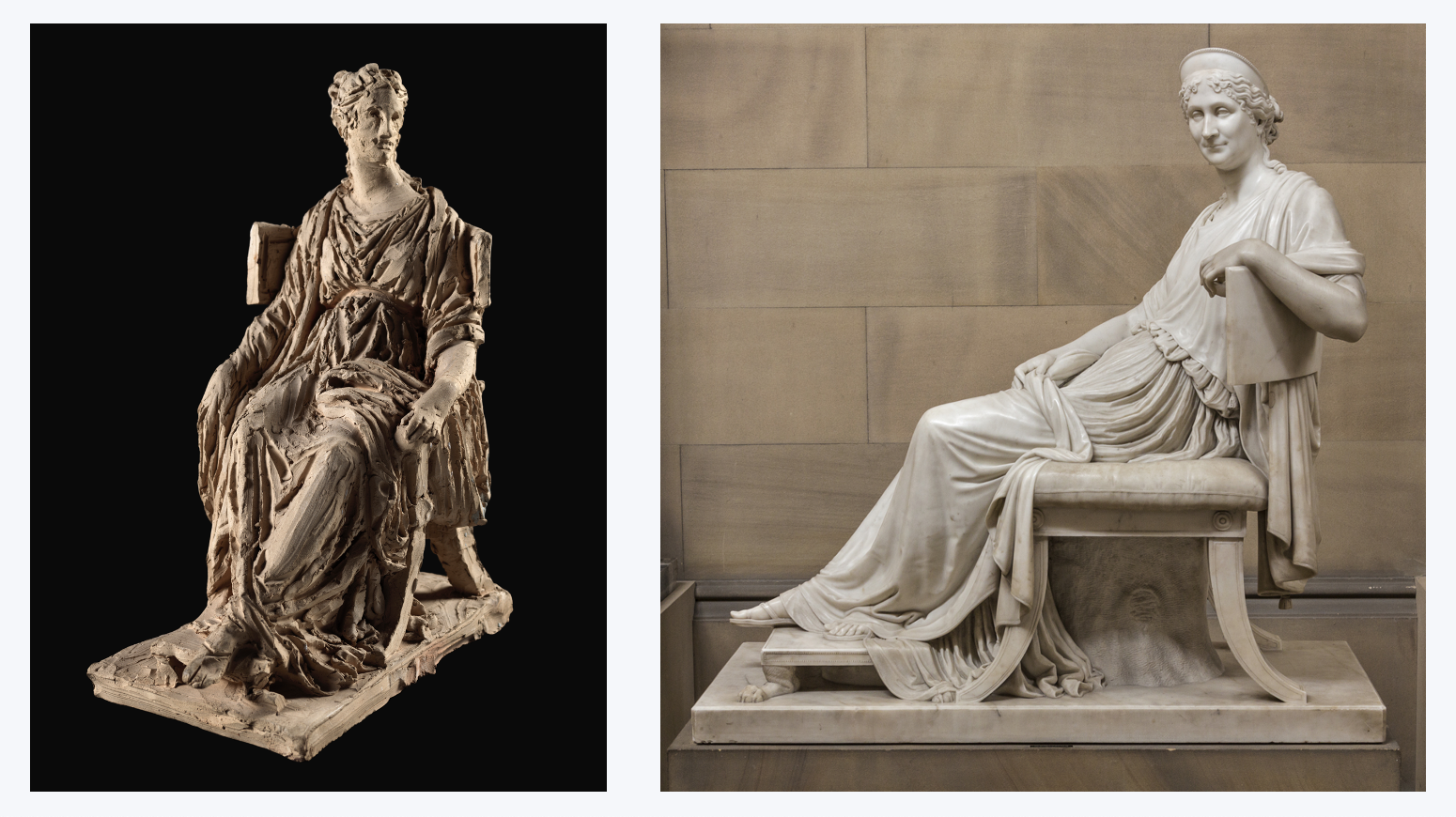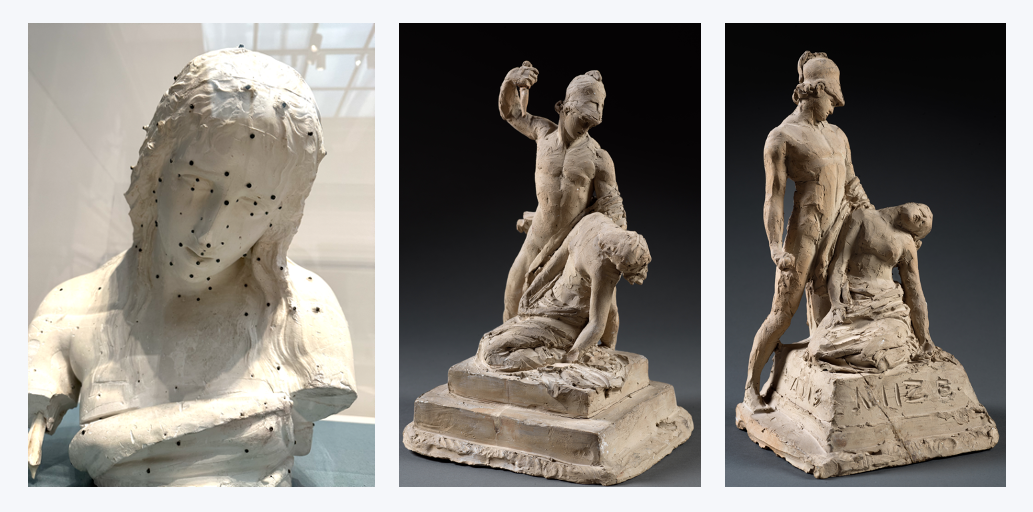
Imperfect Splendor
Napoleonic sculptor Antonio Canova’s clay sketches reveal the passionate struggle of the creative process.
How do you sculpt the mother of a sitting emperor? Carefully and with great deliberation, Antonio Canova would say. When Napoleon Bonaparte’s mother Marie-Letizia visited Canova’s workshop in 1804 for a portrait commission, the famed Italian sculptor first turned to terracotta clay before he committed her form in marble.
Canova’s clay and plaster models are the focus of a new exhibition at the National Gallery of Art in Washington, D.C. This collection of rare and fragile models rarely travel outside of Italy, which makes the exhibition all the more exceptional in offering a chance to explore Canova’s inner creative process. For an artist renowned for his ability to capture the Napoleonic era’s ideal of beauty—think of Psyche Revived by Cupid’s Kiss or the Three Graces—the clay models on view reveal that the path of Canova’s genius was a bumpy one—full of false starts and awkward experimentation, but also creative energy. The models on display in “Canova: Sketching in Clay” humanize the neoclassical artist and bring his process into vivid, tactile focus.
When sculpting Napoleon’s mother, Canova followed a step-by-step system that he had already spent decades refining. He first modelled her in pliable straw-colored terracotta, adding and subtracting clay until an elegant woman in a Grecian chair had materialized. While Canova built his reputation on the studied perfection of his marble statues, these bozzetto—quick sketches in clay—reveal how he grappled with the messy imperfections of creative routine. This process, in all its nonlinear glory, is at the heart of the National Gallery exhibition. The bozzetto from Letizia’s commission are on display in the exhibition’s first gallery, each one almost identical except for subtle changes in posture. In one, her arms lay limply at her side; in another, her ankles are crossed demurely, head turned toward the viewer.
Steps away from these clay bozzetto, in the same gallery we see the culmination of Canova’s experimentation in the form of the final, carved marble statue. Nearly life-size, the sculpture of Letizia Bonaparte is a study in self-assured ease. She leans back comfortably, left arm propped on the back of the chair. With a half-smile and direct gaze, she is relaxed yet commanding, perhaps even to the point of insouciance. There is more warmth than gravitas, unlike the portraits often favored by her son.
Canova’s work met Letizia’s approval; so much so, she asked her son if it could be displayed in the Palais des Tuileries, opposite his throne. Rather than accede to his mother’s wishes, and honor the superb work of Europe’s most renowned sculptor, Napoleon sent it to storage.
We might never know why Napoleon condemned the work to the palace storeroom. Critics at the time noted the sculpture’s striking similarity to a well-known ancient Roman statue then on display at the Capitoline, thought to portray either Agrippina the Elder or Agrippina the Younger. To debate which Agrippina is a moot point—the former was the mother of Caligula, and the later, the mother of Nero. Despite being a commercially successful sculptor who went to great lengths to please his clients, Canova couldn’t fully commit himself to the Napoleonic propaganda effort. He was, after all, a pro-papal sculptor whose adopted homeland of Venice had been conquered by Napoleon.

Terracotta clay, dug out of a damp bin in his workshop and malleable like cream cheese, offered Canova the critical bridge between conception and final execution in marble. He would start with the clay, shaping and perfecting the human bodies he would later sculpt. Those who knew Canova knew the passion he had for this intensely inventive phase of the process. His personal secretary later in life, Melchoir Missirini, wrote that Canova shaped his models in a state of creative ecstasy, “with tears, with happiness, and with general convulsions of his body.” For Canova, this stage of sculpting was a private matter.
At the turn of the 19th century, Rome was a highlight on the Grand Tour circuit favored by many wealthy British and European travelers. Ever the savvy businessman, Canova opened his studio to these tourists, along with the artists, collectors, scholars. However, he had a clear delineation between his studio’s public and private spaces. Still in Canova’s time, the process of marble sculpting was seen as part genius and part manual labor, with studio assistants taking on the bulk of the unwieldy work of marble carving. His assistants’ marble carving was completed in the main public area of the studio, where all could observe; Canova sculpted his clay models in the back studio, off limits to public visitors. This physical separation of labor hints at the demands of the creative process, and the level of concentration needed to conceive and develop his compositions
Canova’s initial rough clay sketches were about the size of a desktop sculpture. Reminiscent of the sculptures Rodin would shock the world with a century later, these bozzetto could be completed in minutes. Next, Canova would create a half-scale clay sketch that allowed him to further refine the drapery and pose of his subject. Following that model, he would complete one more clay sketch, a very detailed and near-perfect full-scale clay model (called a modelli), which would then be cast in plaster. This plaster facsimile was used to transfer the design onto a block of marble, an intricate process handled by Canova’s assistants. After the bulk of marble carving was done by the assistants, Canova would handle the final stages, carefully detailing the flesh, hair, and clothing. The last element to be carved, always, were the eyes.
Given Rome’s role as the center of Roman and Greek antiquity at the turn of the 19th century, and the neoclassical demand for replicated statues, Canova would have had no shortage of skilled labor to transfer his designs from plaster to marble. After driving a series of inlaid metal points on the full-scale plaster facsimile, Canova’s assistants used a wooden frame with hanging plumb lines to replicate the sculpture’s coordinates onto the block of stone.
One of the most intriguing objects in the NGA exhibition alludes to this process—a plaster cast of Mary Magdalene from Canova’s workshop, prepared for transfer to marble. Her remorseful and downturned face is covered in small metal points that have been hammered into her key features—the bridge of her nose, the corners of her eyes, the bow of her lips. When viewed as a discrete object independent of the sculpting process, the plaster cast of Magdalene is stunning in its expressiveness, implicative of penance and sacrifice. It’s an elegant inclusion by curators C. D. Dickerson, III, and Emerson Bowyer that speaks to both the technical details of Canova’s process and the forceful outcomes that his process achieved.

Canova’s clay models also show us what might have been, as he experimented with different ways of melding form, idea, and emotion. The NGA exhibition features two clay sketches depicting the sacrifice of Polyxena, a scene from Greek mythology that Canova toyed with but never executed in marble. After the fall of Troy, as the myth goes, the ghost of Achilles appeared to the Greeks and demanded the death of Trojan princess Polyxena, whom he believed had betrayed his trust by revealing his heel as his mortal weakness.
Canova offers us two different conceptions of Polyxena’s death. In one clay model, Achilles’ surviving son Pyrrhus stands over a kneeling Polyxena, dagger raised in his outstretched arm. As if guided by the spirit of his slain father Achilles, Pyrrhus’ energy and violence dominate the sculpture’s composition. The second model offers a different interpretation by depicting Pyrrhus after the deed is done. He stands over Polyxena, having slit her throat, and now rests his dagger against his thigh. It’s a constrained composition, inward and reflective as Pyrrhus contemplates his actions. We see Canova at an artistic crossroads, weighing the dynamism of one model against the psychological gravity of the other. We’ll never know which model Canova favored. And that’s a good thing, creating space for the abandoned drafts and ambiguity that is innate to the creative process but often concealed in our representations of great artists.
When museums revisit old masters, it can often feel like curators are reaching into the dusty corners of their collection for some new angle on an old crowd-pleaser. By focusing solely on Canova’s process and relationship with clay, the NGA deftly avoids any such accusations. This exhibition offers a riveting footnote to Canova’s oeuvre, a chance to explore the creative value of experimentation and struggle. For anyone who has written, painted, composed, or produced via any range of creative endeavor, the exhibition offers proof that the great masters struggled, too, and in marvelous form.
Carolyn Stewart is the managing editor of American Purpose.
“Canova: Sketching in Clay” is on view at the National Gallery of Art in Washington, D.C., through October 9, and at The Art Institute of Chicago between November 19, 2023 and March 18, 2024.
Image: Terracotta study of a boy, Antonio Canova, 1790-1800. (photo by author)
American Purpose newsletters
Sign up to get our essays and updates—you pick which ones—right in your inbox.
Subscribe






